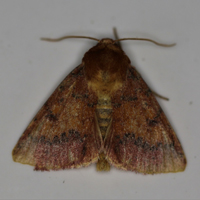False-foxglove Sun Moth
Scientific name: Pyrrhia aurantiago

Photo credit: Eric Giles CC BY-NC 4.0
Status
Endangered
“Endangered” means the species lives in the wild in Ontario but is facing imminent extinction or extirpation.
Date added to the Species at Risk in Ontario List
January 26, 2022
Read the assessment report (PDF)
What it looks like
The False-foxglove Sun Moth belongs to the family Noctuidae, which are also known as owlet moths. Adults are approximately 30 mm long with a wingspan of 25-33 mm. The forewing is dark orange at the base and purple on the outer third, separated by a dark, jagged band. The hindwing is yellowish at the base, grading into dull red or pink on the outer third. The thorax and abdomen are covered with orange hairs. Younger larvae are whitish to yellowish and unmarked. Mature larvae are an overall dark brown with paler stripes on the sides and back and blackish patches on the head.
Where it lives
False-foxglove Sun Moth inhabits oak-dominated savannas and open woodlands. Globally, False-foxglove Sun Moth ranges from southern Maine west through southern Ontario and southern Wisconsin and south to eastern Texas and central Florida.
Where it’s been found in Ontario
In Ontario, the species ranges in southwestern Ontario from eastern Lake Erie, west to Lake Huron and south to Windsor. Its habitats include dry sandy or loamy soils near the Great Lakes.
There are four known subpopulations of the moth in Ontario, located in the Pinery area, the Ojibway Prairie Complex at Windsor, London and Delhi, although the London and Delhi subpopulations are considered extirpated. The populations in Ontario comprise the full Canadian distribution of the species, so where they are found mark the northern edge of the species’ global range.
What threatens it
The larvae of False-foxglove Sun Moth feed exclusively on Smooth Yellow False Foxglove (Aureolaria flava) and Fern-leaved Yellow False Foxglove (Aureolaria pedicularia), both of which are also species at risk in Ontario. False-foxglove Sun Moth has probably declined as a result of the decline of both its host plants and associated habitat. Oak-dominated savannas and open woodlands, which provide important habitats for these host species, have been estimated to have declined by 99% in Ontario.
Canadian subpopulations of this moth are now largely restricted to protected areas where the primary threats are over-browsing of the larval host plants by native White-tailed Deer and the effects of competition from invasive plants on the host plants.
Action we are taking
Endangered species and their habitat are protected under Ontario’s Endangered Species Act, 2007.
What you can do
Report a sighting
Submit your observations of species at risk to the Natural Heritage Information Centre (NHIC), which is Ontario’s conservation data centre. Join the “(NHIC) Rare Species of Ontario” project in iNaturalist to make submitting your observations quick and easy.
Volunteer
Volunteer with species at risk programs, such as community science surveys, through your local nature club, a provincial park or other conservation organizations.
Be a good steward
- Individuals, communities and organizations across the province who undertake stewardship or research activities that benefit species at risk and their habitats may be eligible to receive funding through the Species at Risk Stewardship Program (SARSP). The SARSP was created to encourage people to get involved in protecting and recovering species at risk in Ontario through stewardship actions.
- Invasive species seriously threaten many of Ontario’s species at risk. To learn what you can do to help reduce the threat of invasive species, visit:
Report illegal activity
Report any illegal activity related to species at risk to
Quick facts
- Females lay eggs on the flowers of a host plant. The host plants for False-foxglove Sun Moth are Smooth Yellow False Foxglove (Aureolaria flava) and Fern-leaved Yellow False Foxglove (Aureolaria pedicularia), which are also species at risk in Ontario.
- Adults are nocturnal and visit flowers for nectar.